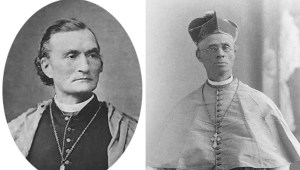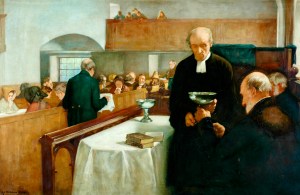We support our Publishers and Content Creators. You can view this story on their website by CLICKING HERE.
Pioneering priests such as Frs. Jean-Baptiste Lamy and Joseph Projectus Machebeuf are unsung heroes of Christendom, but deserve to be recognized.
From Nebraska, from Arkansas,
Central inland race are we, from Missouri, with the continental blood intervein’d,
All the hands of comrades clasping, all the Southern, all the Northern,
Pioneers! O pioneers! —Walt Whitman
Walt Whitman’s poem, inspired by the adventurous spirits who formed the vanguard of the westward expansion of the United States, was itself the inspiration for the title of Willa Cather’s novel O Pioneers!, a romance of life on the western prairies at the turn of the twentieth century.
In a similar vein, Cather’s novel Death Comes for the Archbishop tells the story of two pioneering priests in the “wild west” of New Mexico. Ostensibly a work of historical fiction, the novel is based on the lives of Fathers Jean-Baptiste Lamy and Joseph Projectus Machebeuf, the former of whom would become the first archbishop of Santa Fe and the latter the first bishop of Denver.
Fr. Lamy was born in the mountainous Auvergne region of France in 1814. Ordained to the priesthood in 1838, he arrived in the United States in the following year to serve as a missionary in the virgin west of the expanding New World. Having served in parishes in Ohio and Kentucky, he was appointed by Pope Pius IX to be the first bishop of the newly created Apostolic Vicariate of New Mexico in 1851.
The journey from the Midwest to the “wild west,” in the days before the railroad, necessitated months of arduous travel. In Willa Cather’s fictionalized account, the journey would take almost a year, beginning with a riverboat down the Mississippi to the Gulf of Mexico, a shipwreck at Galveston, and finally a long overland trek to New Mexico. This retelling of the real-life journey enables us to appreciate the hardships faced by the newly consecrated bishop. Having set out early in the new year, he didn’t finally arrive in Santa Fe until August 1851. Two years later, the Vicariate of New Mexico became the Diocese of Santa Fe.
Bishop Lamy set about building churches and establishing new parishes and schools, and he instigated and oversaw the construction of the Cathedral Basilica of St. Francis of Assisi. When the Diocese of Santa Fe was elevated to an archdiocese in 1875, Lamy became the first archbishop, serving for a further ten years until his retirement. He died of pneumonia in 1888, at the age of seventy-three, a good and faithful servant who had served the Church in the United States for almost fifty years.
Fr. Joseph Projectus Machebeuf, the inspiration for the other priest protagonist in Death Comes for the Archbishop, was a lifelong friend of Fr. Lamy. Two years older than Fr. Lamy and born in the same area of the Auvergne, he accompanied his friend to the United States as a missionary priest in 1839 and served in parishes in Ohio until 1851, at which point he accompanied the newly-consecrated Bishop Lamy on his arduous journey to New Mexico. After serving as a pastor in Albuquerque and Santa Fe, he was transferred to Colorado in 1860. Thrown from his carriage on a spur of the Rocky Mountains, he was left lame for the rest of his life.
By 1868, when he was appointed Vicar Apostolic of Colorado and Utah, he had built eighteen churches, including the first-ever church in Denver. He would build a school, a convent and a hospital, as well as the College of the Sacred Heart, which is now subsumed within Regis University. By the time he was consecrated as the first bishop of the newly-created Diocese of Denver in 1887, the Catholic population of Colorado had grown to over 50,000. He died two years later, at the age of seventy-six.
Two other pioneering priests, contemporaries of Lamy and Machebeuf, warrant a place in the roll call of unsung heroes.
Pierre-Jean De Smet, was a Jesuit missionary to the Native Americans, best known perhaps as a friend of the Sioux chief Sitting Bull. Born in 1801 in Dendermonde in what is now Belgium, Fr. De Smet came to the United States as a young seminarian with eleven other Jesuit missionaries in 1821. Following his ordination in 1827, he devoted his life to missionary work among the Native Americans in the still wild west. In 1840, he offered the first ever Mass in Wyoming during a mission trip in which he baptized 350 Salish and Pend d’Oreilles tribesmen.
Befriending Sitting Bull, he persuaded the Sioux chief to enter into peace negotiations with the American government, resulting in the Treaty of Fort Laramie in 1868. Tireless in his pursuit of souls, it is said that Fr. De Smet travelled 180,000 miles in his labors as a missionary.
Fr. Samuel Mazzuchelli was an Italian Dominican, born in Milan, who was ordained as a subdeacon in the Lateran Basilica in Rome in 1827. In the following year, still only eighteen years old, he arrived in the United States, being ordained by the bishop of Cincinnati in September 1830. For his first assignment, the young priest was sent to serve as a pastor on Mackinac Island, after which he spent a life of indefatigable service to the Church, establishing many parishes in Wisconsin, Illinois, and Iowa, blazing a trail as a missionary. He died in 1864.
A century later, the bishop of Madison began the cause for his canonization. He was declared Venerable by St. John Paul II in 1994. In 2001, a man suffering from lung cancer prayed to Venerable Samuel Mazzuchelli for a miraculous cure and discovered later that the cancerous tumor had disappeared. An investigation into the possible miracle was opened by Bishop Robert Morlino in 2008 and the results were subsequently sent to Rome.
We’ll conclude with the words with which Willa Cather concluded Death Comes for the Archbishop:
When the Cathedral bell tolled just after dark, the Mexican population of Santa Fé fell upon their knees, and all American Catholics as well. Many others who did not kneel prayed in their hearts. Eusabio and the Tesuque boys went quietly away to tell their people; and the next morning the old Archbishop lay before the high altar in the church he had built.
Republished with gracious permission from Crisis Magazine (November 2024).
This essay is part of a series, Unsung Heroes of Christendom.
The Imaginative Conservative applies the principle of appreciation to the discussion of culture and politics—we approach dialogue with magnanimity rather than with mere civility. Will you help us remain a refreshing oasis in the increasingly contentious arena of modern discourse? Please consider donating now.
The featured image combines public domain photos of Frs. Jean-Baptiste Lamy and Joseph Projectus Machebeuf, courtesy of Wikimedia Commons.
Share This Story, Choose Your Platform!
Go to Top

 Conservative
Conservative  Search
Search Trending
Trending Current News
Current News 







